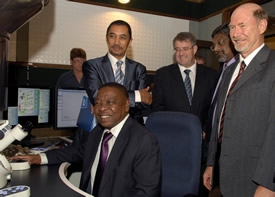| 90% of readers believe that mobile technology and increasing online access make social media an ideal platform for attracting younger generations of South Africans to SET fields of study. | |
| 5% of readers say they are not sure. | |
| 5% of readers say that this time and money could be better spent on outreach projects. |
Exoplanet extraordinaire… Only a few weeks into the new year and already four new exoplanets have been discovered. An exoplanet is a planet that orbits a star in a solar system other than that of the earth. It looks as though 2012 is going to be a year filled with discovery.
Read more
IN THE NEWS
NMMU zooms in on nano research
 |
Minister of Higher Education, Blade Nzimande, operating the new High Resolution Transmission Electron Microscope at NMMU during its launch (seated). Back from left: Professor Derrick Swartz (NMMU vice chancellor), Doctor Albert van Jaarsveld (NRF CEO), NMMU Council Chairperson Judge Ronny Pillay, and Professor Jan Neethling (NMMU). |
|
In October last year, the first high-resolution transmission electron microscope (HR-TEM) with atomic resolution ever to be employed on the African continent was launched at the Nelson Mandela Metropolitan University (NMMU). SAASTA developed a media pack containing three fact sheets as well as photos for the launch, which received wide coverage in the media.
The atomic resolution HR-TEM is one of four new microscopes in a R120 million teaching and research facility housed at NMMU in Port Elizabeth. The facility is a strategic intervention by the NRF, the Department of Science and Technology (DST), the Department of Higher Education and Training (DHET), the NMMU, and Sasol. This joint venture is proof of how government and industry are investing in South African nanotechnology and attracting business into the country.
The HR-TEM means that academics, universities, and many local companies can now utilise nano research that was previously out of reach because of the challenges involved in accessing high-resolution instruments internationally. The aberration-corrected HR-TEM technology is also in line with government’s nanotechnology programmes.
The HR-TEM uses beams of electrons to create an image of a specimen. A focused beam of electrons passes through the sample and interacts with it. The electrons are diffracted in patterns that can be transformed to produce an image of the structure of the material. Previously HR-TEMs had a resolution of over 1Å (10–10 m). The diameter of an atom is less than 1Å. Although these instruments were, and still are, useful in determining the crystalline structure of many materials, they are not capable of resolving individual atoms.
Academics from NMMU and other universities as well as industrial research scientists from Sasol and other companies will use the HR-TEM in a number of broad applications.
NMMU Professor Jan Neethling and his group have led the country in the fundamental understanding of the HR-TEM for materials science research, but until now have had to go abroad to use state-of-the-art microscopes for their research. Neethling pioneered the Centre for HR-TEM at the university and has the expertise to train others in the use of these techniques.
